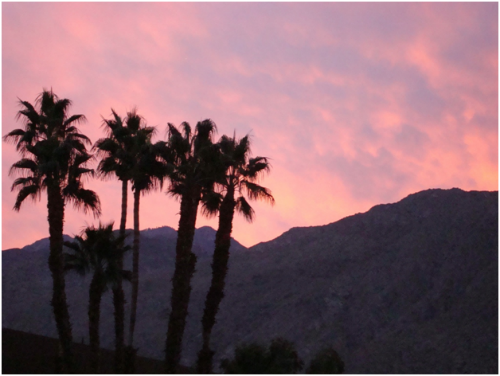Palm Springs Weather: Current Conditions & Seasonal Trends
What's the Weather Like in Palm Springs, California?
When people think of Palm Springs, California, they usually imagine days full of sweltering desert heat. And while it's warm and sunny here a lot of the time, the temperatures hit three digits only a few months of the year.
While the region has about 350 sunny days annually, it's not always hot. The Coachella Valley experiences a range of weather conditions, from the dog days of Summer to chilly winter months that dip into the 40s at night. And it can get quite windy at times, due to the ranges of mountains nearby; see our Palm Springs wind map for more info on the breezier locations.
In this article, we will cover the seasonal changes in Palm Springs weather and fill you in on how it can impact your decision on buying a home here.
Current Palm Springs Weekly Weather Forecast
PALM SPRINGS WEATHER.jpg)
What's the Average High and Low Temperatures In Palm Springs?
Palm Springs weather does get quite steamy in the summer months, with daytime temperatures over 100 from about Memorial Day to late September. During those three to four months, we experience real desert heat, and temps can climb to 115 to 120 then.
But, as the old saying goes, it's usually a "dry heat" without much humidity, so even at 110, it doesn't regularly feel muggy or sticky.
With that said, those few summer months are often best spent in air-conditioned comfort, with evening or morning dips in the pool. Many locals run errands early in the day or after sunset, when the temperatures dip a bit.
The other eight or nine months of the year bring exceptional weather, lots of sun, ideal temperatures, and glorious views...making Greater Palm Springs of the best places to live.
Spring and summer evenings get down to the low 70's, perfect for outdoor recreation and entertaining. Wintertime can bring a bit of rain -- it's rare, but can be substantial when it comes -- along with cooler temperatures and more windy conditions.
Between Labor Day and mid-May, daytime temps range in the 60's and 70's, and evening temperatures may have you grabbing your winter jacket. Overnight, the outside thermometer will often hit 45 or 50, sometimes less.
Palm Springs locals kid that we have the perfect weather eight months of the year, with stunning sunny blue skies and beautiful mountain views. And we learn how to adjust our lifestyle to deal with those few summer months of 100+ heat or escape to cooler environs then.
It used to be that Palm Springs mostly shut down in the Summer due to the heat -- stores closed, streets were empty, many locals departed for somewhere cooler. That's changed a lot, and the city still bustles in the Summer months, just at a somewhat slower pace.
Let’s take a look at the seasonal trends when it comes to Palm Springs, CA weather, including current conditions like temperature, time, and moon phases.
Winter in Palm Springs: December through February Weather
Winters in Palm Springs are among the mildest in the continental United States. Like the rest of Southern California, winter is the rainy season, but it's not really a "season" as much as few days of rain. Palm Springs CA only receives just about five inches of rain per year, and when it occurs, it can be torrential. It's sunny here most of the time, but a bit more breezy in these months with temps in the 60s and 70s.
It’s the snow-capped mountains to the west of Palm Springs that let you know it’s winter. The mountains block most of the moisture from reaching the desert, but as the clouds swirl around them, they drop rain and, at the higher elevations, snow. After the storms, the peaks are covered in white, creating a beautiful contrast between those snow-topped mountains and the palms, sunshine and lush gardens on the desert floor below.
You’ll be warm outside if you’re in the sun, but in a shady canyon or when the sun goes behind the mountains, you may need a jacket. It can get downright cold in the desert during these winter months, though freezing temperatures are very rare.
Due to Palm Springs’ desert climate, nights can be cool, as the desert air doesn’t retain heat. Nighttime low temperatures can drop to around 40°F, with prevailing winds from the northwest at speeds of 5-10 mph.
If you’re considering a trip up the Palm Springs Tram, expect cold temperatures and snow due to its high elevation. You might also see snow if you visit Joshua Tree National Park, as it’s also at a higher elevation than Palm Springs and the rest of the Coachella Valley.
In winter the "snow birds" arrive, seasonal visitors and second homeowners (many from Canada), and “the season” opens with popular events, such as the Palm Springs International Film Festival and Modernism Week.
If you’re wondering what the Palm Springs weather trends are like because you’re thinking of becoming a snowbird and buying a vacation home in the area, read my blog on everything snowbirds need to know about buying a home in Palm Springs. If you have more questions about this process or you have a particular home in mind, get in touch with me and I’ll be happy to help.
Spring in Palm Springs: March through May Weather
Spring starts early in Palm Springs, California.
While folks back east are still shoveling snow, temperatures rise here, with averages from the 50s to 90° F (11 – 34°C), and wildflowers come out. High temperatures can reach 101°F, 103°F, and even 107°F during this season. This is “the height of the season” in the desert – the most popular time for visitors. This is when many of the major annual events take place, such as the Coachella Music Festival, the White Party and Dinah Shore weekend. It’s a time when you proabably need dinner reservations, and some of the hiking trails are busy.
Any winter rain is usually over before March, the days are warmer, the nights balmy, and the desert blooms. The abundance of seasonal wildflowers depends on the amount of winter rain, but even the smallest amount brings out desert natives, such as brittlebush, desert lavender, globe mallow and cactus flowers. Palo Verde trees glow yellow, and ocotillo are tipped with red flowers. The canyon creeks are running full, and waterfalls, such as Tahquitz and West Fork are at their most spectacular.
By April and May, even unheated pools warm up. Late spring in the desert is like summer elsewhere, without the humidity, making this the most comfortable and thoroughly enjoyable time of year.

Summer in Palm Springs: June through September
June is a transition month from spring to summer, with the sunrise at about 5:30am and the sunset at 8pm. July, August and September are the warmest in Palm Springs. Daytime temperatures during these months almost always reach triple digits.
But it’s important to keep in mind that 105° F (40° C) in the dry desert air doesn’t feel as hot as a humidity-laden 90° F (32° C) in Atlanta or New York. Mornings are still cool enough for tennis, golf or hiking, and evenings are terrific for outdoor dining and pool parties. Late summers occasionally bring evening thunderstorms with dramatic displays of lightning.
As noted earlier, people didn’t used to come to the desert in summer, but that’s changed. The consistently sunny weather in Palm Springs, with high temperatures and clear skies, has made splash parties and summer events a hot ticket at local hotels. Some luxury resorts have great deals on wellness and spa weekends, but things are still quiet enough that you may not need dinner reservations.
Fall in Palm Springs: October and November
Autumn is beautiful in Palm Springs!
Halloween is warm enough that you don't freeze in your skimpy costume, and you can even have Thanksgiving dinner al fresco. The Greater Palm Springs Pride parade and festival is the first weekend in November, and shorts and t-shirts (or no shirts) still rule. Daytime highs range from the 70s to the 90s (21-32° C), while nights can dip into the 50s (10° C), so a change of clothes for evening is advised.
If you're looking for fall colors on the trees, you won't get much of that here. But you can drive to nearby Idyllwild or go hiking at the top of the Tram to experience fall foliage.
Weather Summary for Palm Springs
With about 350 days of sunshine per year, Palm Springs has four distinct seasons, each one welcoming and beautiful in its own way. It's a climate that encourages outdoor living and activities, night and day.
The locals have known the secret of Palm Springs weather for years -- shhh, don't tell anyone! It's stunningly beautiful here, and a few months of summertime heat are an easy tradeoff for the glorious weather we have the rest of the year!
If you have questions about buying a home in Palm Springs, connect with me, Geoffrey Moore, for more information. I'm your expert guide for all things Palm Springs real estate!

